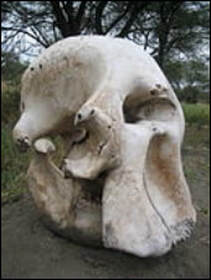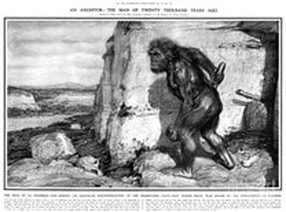Sometime in the early 1990s, I was reading a children's book to one of my sons. The book was on elephants, and was part of a series of books that we got in the mail. My boys were fascinated by them, and we read them over and over.
One double-page spread in the book presented an idea that intrigued my son. It asked, "did you know that the story of the cyclops was probably started by an elephant skull?"

from Zoobooks: Elephants, copyright 1986 by Wildlife Education, Ltd.
It went on to explain that the concept of a one-eyed giant was probably conceived by someone who had never seen
a live elephant, but found an elephant skull. Looking at the skull at the beginning of this blog, it's easy to see how the giant nasal hole that is where an elephant's trunk attaches could be misconstrued to be an optical socket.
So, how would an ancient Greek stumble across an elephant skull? Perhaps it wasn't an elephant at all, but a mammoth. Believe it or not, there were mammoths in the region, even on the islands. It may be possible that many Greek myths originated from an attempt to explain these fossils.
a live elephant, but found an elephant skull. Looking at the skull at the beginning of this blog, it's easy to see how the giant nasal hole that is where an elephant's trunk attaches could be misconstrued to be an optical socket.
So, how would an ancient Greek stumble across an elephant skull? Perhaps it wasn't an elephant at all, but a mammoth. Believe it or not, there were mammoths in the region, even on the islands. It may be possible that many Greek myths originated from an attempt to explain these fossils.
The question then arises: Did ancient Greeks find a mammoth skull and invent the story of the cyclops to explain it?
Or did the story of the cyclops begin as a story of hunting mammoths, which changed over time as people forgot what mammoths looked like? Could it be that the story of the cyclops is a very, very old story that adapted to the time in which it was told?
If a mammoth, or at least its skull, could become a cyclops, what other monsters from myths and legends had actually begun as real creatures?









No comments:
Post a Comment